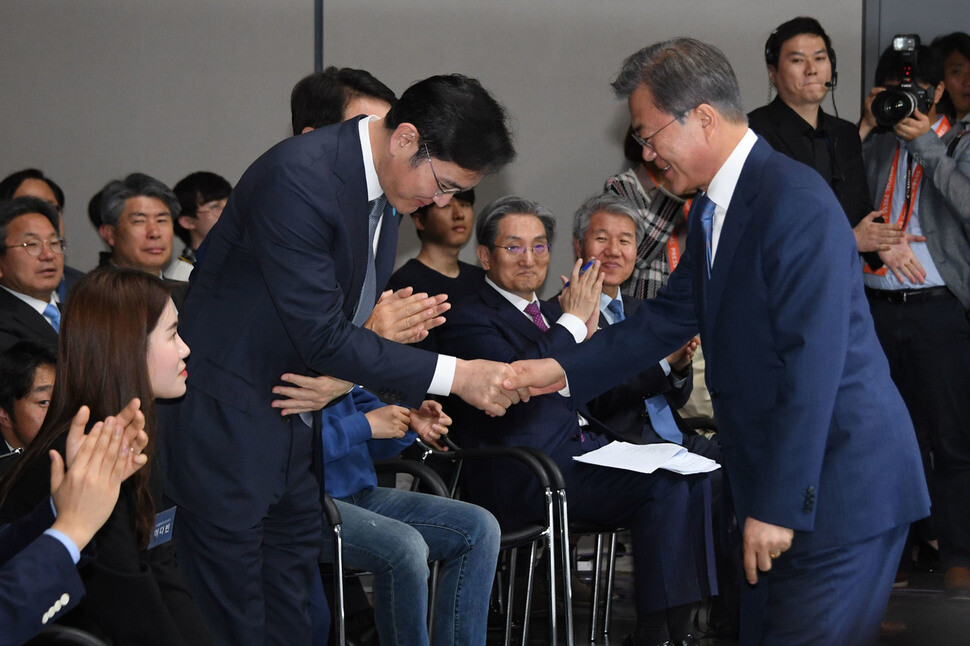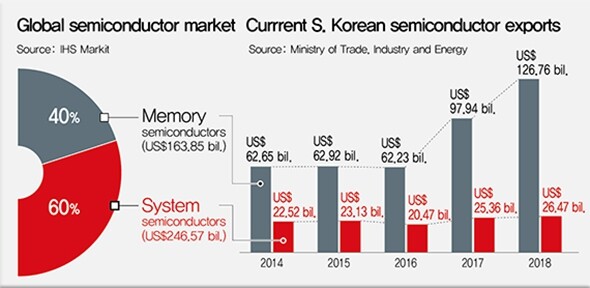hankyoreh
Links to other country sites 다른 나라 사이트 링크
Moon admin. teams up with Samsung in system semiconductors

The Moon Jae-in administration is teaming up with Samsung. In his first visit to a domestic Samsung Electronics factory since taking office, South Korean President Moon joined Vice Chairman Lee Jae-yong in declaring system semiconductors as a driving force for economic growth. Observers are viewing the move as the Moon administration’s full-scale return to a chaebol-centered growth strategy following its recent shift in focus from income-driven to innovation-based growth.
Attending a “system semiconductor vision” declaration ceremony on Apr. 30 at a Samsung Electronics plant in Hwaseong, Gyeonggi Province, Moon said, “I applauded Samsung Electronics’ selection of an ambitious target, which the administration will actively work to aid.” His remarks appeared to be in response to Lee’s Apr. 24 announcement of the company’s “2030 semiconductor vision,” which involves investing 133 trillion won (US$114.24 billion) in system semiconductors through the year 2030.
Praising Samsung’s work in semiconductors, Moon said, “Our standing as world number one in memory semiconductors has upgraded the competitiveness of the products we have made.”
“‘Made in Korea’ items with the world’s first and best memory semiconductors have become another name for ‘cutting edge,’” he added.
He went on to announce the target of “maintaining the world’s top ranking in memory semiconductors, while making the leap to become an overall semiconductor superpower by becoming global number one for system semiconductor foundries by 2030 and achieving a 10% share of the fabless market.”
Lee said he “sensed a great sense of responsibility when the president spoke of ‘made in Korea’ and his vision of an overall semiconductor superpower.” He added, “I intend to make us the clear top producer of system semiconductors as the president requested.”
Moon and Lee also inspected the construction of an extreme ultraviolet (EUV) wing, which is scheduled for completion this October. Moon asked Samsung Electronics President Jung Eun-seung – who oversees the foundry effort – whether he felt “confident,” to which Jung replied, “We will make sure to achieve what we have achieved in the past.” Moon patted Lee on the back as they left the site.
The event on Apr. 30 was the first step taken by Moon since the Blue House and his administration named non-memory semiconductors, bio, and future automobiles as the “top three industries for focused development” on Apr. 22 It sent the message that the administration looks to spearhead a drive by the non-memory semiconductor industry – including system semiconductors – at a time when South Korea’s first quarter economic growth rate was calculated at -0.3%.
Analysts also suggested Samsung Electronics would join the transition at a time when sluggish performance in memory semiconductors would force the company to expand into the non-memory field. First quarter performance figures announced the same day showed the company recording its worst operating profits in 10 quarters.

Backpedaling on promises to reform economy?
Experts supported the idea of fostering South Korea’s system semiconductor industry, but voiced concerns about the shift in the administration’s economic focus. The fears echo recent concerns that the administration is backpedaling on its commitment to income-driven and innovation-based growth. Indeed, some observers are noting the absence of visible achievements with the “fair economy” and “chaebol reform” three years into the administration, including amendments of the Commercial Act and Fair Trade Act. Alongside non-memory semiconductors, Hyundai Motor’s hydrogen-powered vehicle project has been named as a chief focus in the “future vehicle” industry fostering plan. The chaebol-centered ecosystem is poised to only grow more entrenched as the administration teams up with Samsung Electronics on non-memory semiconductors, and now Hyundai Motor on future vehicles.
“The Moon Jae-in administration has said that it’s driving growth through innovation in other areas like SMEs and venture enterprises without relying on chaebols as past administrations have done, but his actions today show he’s ended up succumbing to same temptation as past administrations, enlisting chaebol assistance to make the economy look a little bit better,” said Kim Woo-chan, a professor of economics at Korea University and director of Solidarity for Economic Reform.
“It’s a return to an economic approach that relies on chaebol businesses,” Kim said.
Ju Sang-young, a professor of economics at Konkuk University and chairperson of the macroeconomics subcommittee for the National Economic Advisory Council, said, “[President Moon’s] steps today do not align with his focus on income-driven growth or on innovation-based growth, with its emphasis on the industry ecosystem with SMEs.”
“With economic growth rate prospects looking poor, he may be feeling the pressure to generate visible results,” Ju suggested.
The timing has also attracted comments, with some questioning whether it was appropriate for Moon to show his personal support ahead of a Supreme Court ruling on Lee’s case involving embezzlement and bribery accusations. Prosecutors are also currently investigating Samsung BioLogics in connection with efforts to pave the way for Lee’s succession within the Samsung Group. Released with a suspended sentence following his second trial in February 2018, Lee marks the one-year anniversary of his return as Samsung’s chief on May 1.
By Song Gyung-hwa, Choi Ha-yan, and Shin Da-eun, staff reporters
Please direct comments or questions to [english@hani.co.kr]

Editorial・opinion
![[Column] Park Geun-hye déjà vu in Yoon Suk-yeol [Column] Park Geun-hye déjà vu in Yoon Suk-yeol](https://flexible.img.hani.co.kr/flexible/normal/500/300/imgdb/original/2024/0424/651713945113788.jpg) [Column] Park Geun-hye déjà vu in Yoon Suk-yeol
[Column] Park Geun-hye déjà vu in Yoon Suk-yeol![[Editorial] New weight of N. Korea’s nuclear threats makes dialogue all the more urgent [Editorial] New weight of N. Korea’s nuclear threats makes dialogue all the more urgent](https://flexible.img.hani.co.kr/flexible/normal/500/300/imgdb/original/2024/0424/7317139454662664.jpg) [Editorial] New weight of N. Korea’s nuclear threats makes dialogue all the more urgent
[Editorial] New weight of N. Korea’s nuclear threats makes dialogue all the more urgent- [Guest essay] The real reason Korea’s new right wants to dub Rhee a founding father
- [Column] ‘Choson’: Is it time we start referring to N. Korea in its own terms?
- [Editorial] Japan’s rewriting of history with Korea has gone too far
- [Column] The president’s questionable capacity for dialogue
- [Column] Are chaebol firms just pizza pies for families to divvy up as they please?
- [Column] Has Korea, too, crossed the Rubicon on China?
- [Correspondent’s column] In Japan’s alliance with US, echoes of its past alliances with UK
- [Editorial] Does Yoon think the Korean public is wrong?
Most viewed articles
- 1[Column] Park Geun-hye déjà vu in Yoon Suk-yeol
- 2Thursday to mark start of resignations by senior doctors amid standoff with government
- 3Will NewJeans end up collateral damage in internal feud at K-pop juggernaut Hybe?
- 4[Guest essay] The real reason Korea’s new right wants to dub Rhee a founding father
- 5Why Korea shouldn’t welcome Japan’s newly beefed up defense cooperation with US
- 6[Editorial] New weight of N. Korea’s nuclear threats makes dialogue all the more urgent
- 7Kim Jong-un expressed ‘satisfaction’ with nuclear counterstrike drill directed at South
- 8[Column] ‘Choson’: Is it time we start referring to N. Korea in its own terms?
- 9N. Korean hackers breached 10 defense contractors in South for months, police say
- 10‘We must say no’: Seoul defense chief on Korean, USFK involvement in hypothetical Taiwan crisis